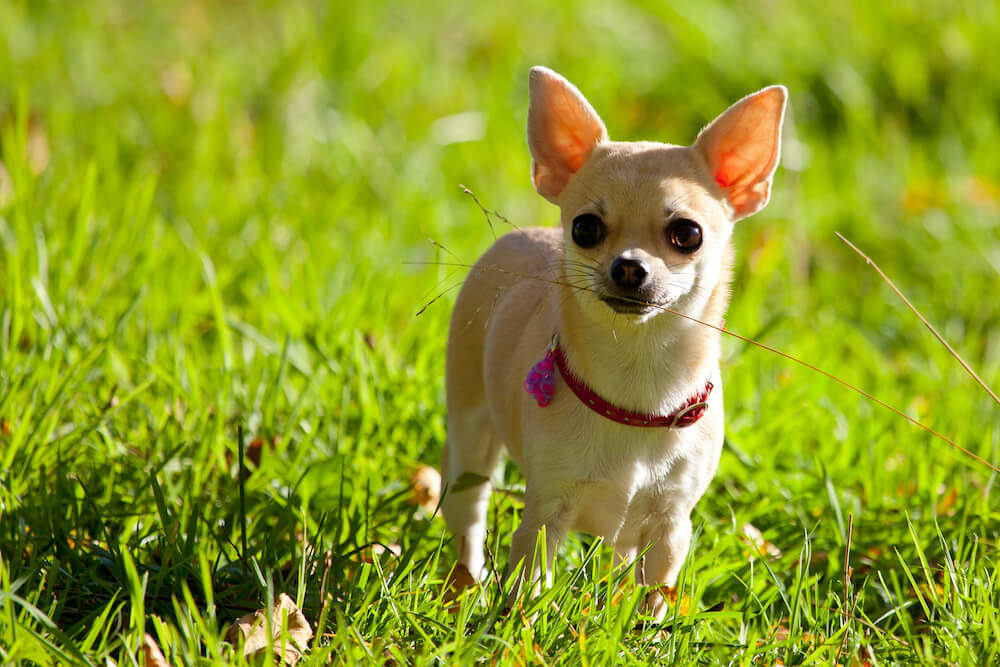The Size Debate: What is Considered a Small Dog?
There’s an age-old debate about what size is considered a small dog.
Confusion tends to swirl around this topic because it can be open for interpretation.
There does happen to be a professional opinion on how much a small dog weighs, and we’ll cover that in this article.
Not only do we discuss the typical upper limit of weight of a small dog, but we also offer helpful information on how to determine how big your puppy will be.

How Big is a Small Dog?
Experts seem to agree that small dogs weigh 22lbs or less.
The general consensus in the pet community is that the weight requirement can stretch to 25lbs.
Small dogs typically stand 10 inches tall, or under, at the shoulders.
This is the breakdown of how canine weight categories are normally separated:
- Small dog: 22lbs or less
- Medium dog: 23lbs-55lbs
- Large dog: 56lbs and over
It’s important to consider the difference between small dog breeds, and dogs that are small.
For example; a Great Dane puppy may be small, but it’s definitely not a small dog breed!
Breed isn’t always the best indication of whether or not your dog can be labeled as a small or medium dog.
People often consider weight the best indicator of how small a dog is.
Small dogs are those that weigh 22lbs or less as full grown adults.
Dog parents and professional opinions would argue that as soon as your dog weighs more than 22lbs, it’s no longer considered a small dog, despite age and breed.
Popular Small Dog Breeds
Some of the most popular small dog breeds include:
- Dachshund
- Chihuahua
- Maltese
- Yorkshire Terrier
- Toy Poodle
- Shih Tzu
- Pomeranian
The popular “toy” and “teacup” subcategories fall under the small dog specification.

So, what about dogs that can fluctuate over and under 22lbs?
Dachshunds are a popular small dog breed, but technically they can stretch past that weight guideline.
Standard Dachshunds can weigh as much as 32lbs! And sometimes even more.
The Dachshund breed classifications say that a Standard Dachshund typically weighs anywhere from 16 to 32lbs.
Does that mean they are small or medium dogs?
It just depends on how much YOUR dog weighs! Is your Dachshund 30lbs (or over 22lbs)? If so, they are considered to be a medium sized dog.
According to the AKC, a dog such as the Dachshund is considered to be a small dog breed, but weight does technically play a factor.
What is Considered a Small Dog for Apartments?
Apartment communities tend to have their own rules, regulations and restrictions when it comes to dogs living on the premises.
Most times, complexes that allow canine tenants have general weight limits on dogs per apartment home.
That limit is often set at 75lbs.
Apartment policies may vary, but the limit for dogs is often under 75 pounds.
Apartments normally do not separate dogs by small, medium or large for purposes of leasing a home.
Generally, as long as your dog is under their proposed weight limit, nothing else matters.
Unfortunately many apartment complexes do discriminate against certain breeds, but “small dog breeds” as a generalization aren’t normally listed on those restrictions.
If you have a small dog under 22lbs, or even a larger dog up to 75lbs, they will most likely be accepted into an apartment, condo or other housing community.
There are often to advantages to having a small dog if you live in an apartment though.
An apartment is often big enough for a small dog to thrive, as there is space for a tiny pup to play fetch and tug.
But be careful with yappers – apartment neighbors won’t appreciate a dog who barks a lot.

How to Tell if a Puppy is a Small Breed
If your puppy is a mixed breed dog, you may not know how big they will grow to be.
Will they be a small, medium or large dog?
There is a weight calculation you can use for a prediction.
Take your dog’s six week weight, double it, then double it again.
The number you come up with is a rough estimate of how much your puppy will weigh as an adult.
If that end result is more than 22lbs, your dog will likely be a medium, large or giant breed dog.

New dog parents love to speculate how big their adorable puppies will be.
We’ve all seen a precious pup with massive paws or large ears, but these are rarely true indicators of how big a dog will be, especially if they are a mixed breed.
Sometimes dogs do “grow into their ears” or paws, but the best way to estimate your dog’s final size and weight is to use the calculation we mentioned above.
Why Small Dogs are Popular
Small dogs are popular for several reasons, the main one being all of the love packed into a small body!
Small dogs are great for city or tiny living.
They also make tremendous travel companions because they don’t take up much space in an RV, van or car!
Small dogs often have longer lifespans than larger dogs do.
Small dog breeds may be a longer-term companion too. Small dogs typically have longer lifespans than their bigger canine buddies.
The best example is the Great Dane versus the Dachshund.
The Great Dane lives to be around 7 years old. The Dachshund can live upwards of 16 years, which is more than double the lifespan!
Should your pup become injured or sick, they will be easier to care for and transport if they are small.
Dogs under 25lbs can be lifted and carried with little effort if they break a limb, fall ill, or otherwise need assistance.
Another factor that makes small dogs popular is the lower cost in food, toys, accessories, and medication.
The smaller the dog, the lower the cost in several categories!
For example, feeding a Mastiff will cost a lot more money than feeding a Chihuahua.

Final Thoughts
Small dogs may be small in stature, but they are mighty in personality. Their tiny bodies hold a massive capacity for love.
Even though they are 22lbs or less, small dogs make terrific loyal companions and guard dogs.
Some small dog breeds can even make great adventure companions and travel buddies.
They often attach themselves to a family member and make incredibly buddies in a variety of situations.
In the end, it doesn’t matter how much your dog weighs. As long as you have a loving, trusted bond, that’s what’s most important!
Read More: 25 Dachshund Facts Every Owner Should Know


About the Author
Hi, I’m Jessica. I’ve been studying the Dachshund breed since 2007, owned 3 of my own, and shared in the lives of thousands of others through their owner’s stories. When I’m not sharing what I know on this blog, you can find me hiking, camping, and traveling with my adventurous wiener dogs.

i pastored a church in hawaii for 16 years. our daschund mix always went to the door of the church when it was open and greeted the people. they called hi “church dog” but he never went inside which was good i guess. (maybe we should have had a “saint” bernard.
What is the gestation period for a daschund? once when we were out of town for a few hours a thunder stormhit. we could not find him until a church member called asking if we were looking for our dog. He had run to a neighbors house more than a mile away ran inside and hovered under thier bed until the storm was over. please reply to my email. thanks
bibledocjones@gmail.com
Hi Gordon. I am not able to check my blog comments often in the summer because we are so busy. So I apologize for the delay. I’m not sure how to reply to your question “Gestation period” has to do with how long a mother is pregnant before giving birth but the rest of your comment doesn’t seem to have anything to do with that. Could you please clarify?